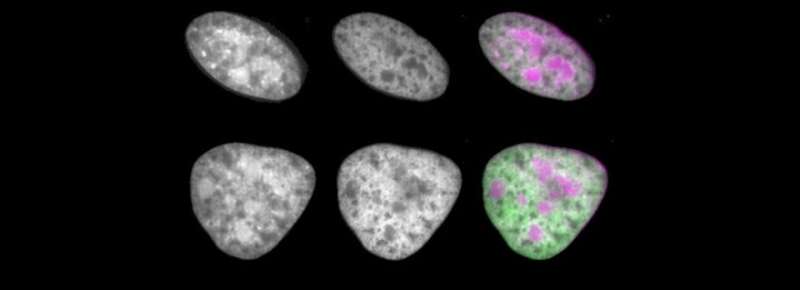Non-invasive DNA-labeling tool opens doors for new research

Dutch researchers have developed a new tool to label DNA for studying chromosomes in live cells. The tool is non-invasive and can be applied in culture but also in living organisms, such as zebrafish embryos. The team published their findings in the journal Nucleic Acids Research.
Scientists want to have ways of visualizing what's going on in cells at the chromosome level. One way of doing this is by making chromosomes fluorescent. With imaging techniques, researchers can then study the processes in the cell.
Currently, scientists mainly use fluorescent organic dyes, which are small molecules that emit fluorescent light. However, these molecules are not ideal: they cause damage to the DNA when they bind to it, resulting in unwanted changes in gene expression and genome replication. And ironically enough, those are precisely the processes that researchers want to study with this method.
Fundamental bacterial research offers solution
Luckily, postdoc Fatema Zahra Rashid from the Leiden Institute of Chemistry developed a new tool for this. She derived it from a bacterial protein, which group leader Remus Dame in 2006 showed has special DNA binding properties. "For quite some time, we have been wondering how we can use the special properties of this protein," says Dame. "And now, Fatema Zahra finally found an application for it."
By selecting a single module of the protein and fusing this to a fluorescent protein, Rashid made it suitable for DNA labeling. "What's great about this tool is that it doesn't interfere with processes in the cell, precisely as we predicted," she says. "Our study shows that you can even use it in living organisms, such as zebrafish embryos, without harming them. With the previous organic dyes, that was not possible."
New toolbox for scientists
Rashid thinks many scientists can benefit from her new tool. "We made a huge public library of different DNA labels," she says. "Other researchers can use this toolbox for a broad range of purposes, from visualizing the dynamics of chromosomes in live cells to studying the effects of drugs on the cell cycle in drug trials."
Dame says, "This research had a nice collaborative aspect to it. We've worked together with researchers from the Institute Biology Leiden, the Leiden University Medical Centre, the University of Amsterdam and AMOLF. We really needed those experts because our background is more in biochemistry. That's why it was great to have real cell biologists on board. And we could even work together with Annemarie Meijer, who works with zebrafish larvae. Altogether, a great team effort."
More information: Fatema-Zahra M Rashid et al, HI-NESS: a family of genetically encoded DNA labels based on a bacterial nucleoid-associated protein, Nucleic Acids Research (2021). DOI: 10.1093/nar/gkab993
Journal information: Nucleic Acids Research
Provided by Leiden University


















